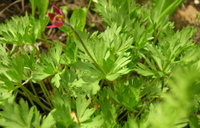A couple of weeks ago I wrote about what happens when sawdust decomposes. But the account was incomplete, and I am here today to rectify that error. Call me honest, call me obsessive; I’m going to set the record straight, sawdust-wise.
I wrote then that sawdust makes a lousy lawn fertilizer because it requires so much nitrogen to decompose, and it contains very little. So far, so good. But when I wrote that “it requires nitrogen to break down, and it’ll make use of whatever it can lay its sawdusty little paws on,” I misspoke.
I know what you’re thinking: sawdust does not have paws. But that’s not where I’m headed. No, what’s at stake here is not anatomy, but agency. It’s a mistake to refer to sawdust as making use of nitrogen or to suggest that sawdust “gets” nitrogen whether with paws, hands, or any other part of its being.
It’s a mistake, in a sense, even to refer to sawdust (or anything else) as decomposing, as if this were something that it did all by itself. In fact, of course, something decomposes it. And not just one something; lots of somethings. These somethings are called—brace yourself—decomposers.






 Subscribe to RSS feed
Subscribe to RSS feed


